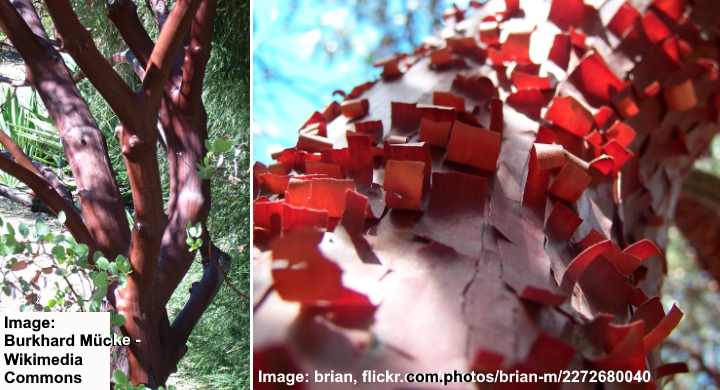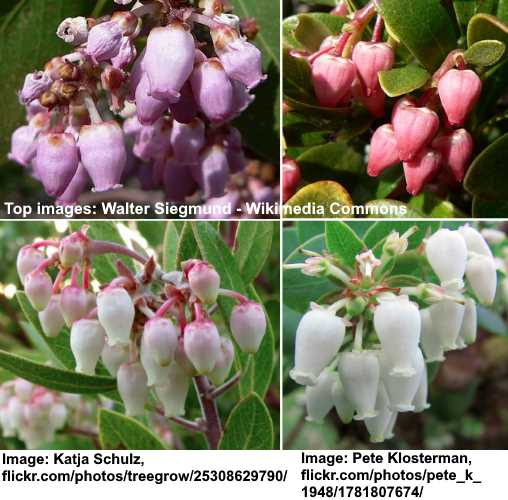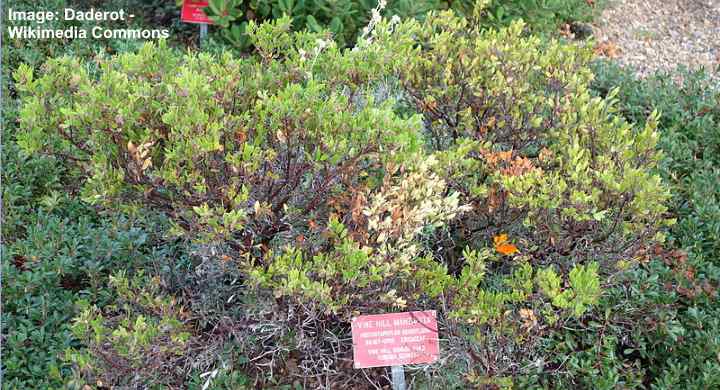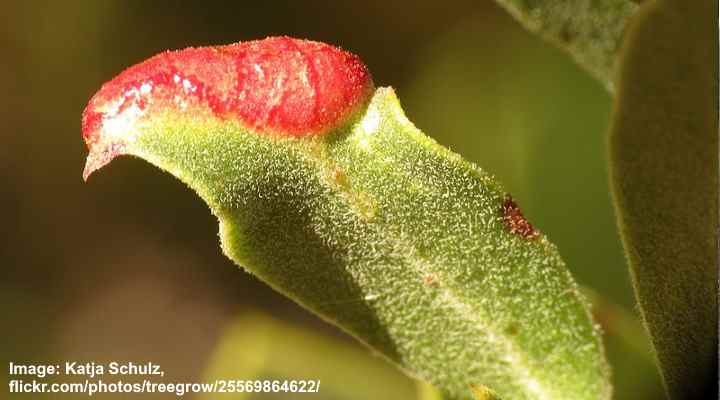Types of Manzanita Trees and Shrubs (With Pictures) – Identification Guide

Manzanita trees and shrubs are attractive flowering plants with eye-catching red bark. The small ornamental trees or shrubs bloom with bell-shaped pale pink or white flowers. However, the most attractive feature of the evergreen plants is the distinctive reddish-brown or mahogany bark covering twisted, gnarled branches. Small manzanita trees or compact bushes can grow as tall as 20 ft. (6 m) tall or be ground-hugging decorative shrubs.
Manzanita trees are a charming addition to any garden landscape that gets mild winters. Due to its evergreen foliage, winter blossoms, and colorful bark, manzanita trees have excellent year-long visual appeal. In addition, manzanita trees are low-maintenance plants tolerant of drought and arid climates.
What are the best types of manzanita trees for your landscape? How can you successfully grow manzanita landscaping shrubs in your yard? What are common problems associated with growing manzanita trees in a garden? This article aims to answer these questions and more.
What is the Manzanita Tree (Arctostaphylos)?

Common manzanita / whiteleaf manzanita tree (Arctostaphylos manzanita)
Manzanita trees are a group of small trees with shrubby growth belonging to the flowering plant genus Arctostaphylos. The trees are native to the western coast of the United States and grow in USDA zones 8 through 10. There are around 60 species of manzanita trees, all of which have evergreen foliage apart from one.
Manzanita trees typically have an upright spreading habit and long, twisted, crooked branches covered in a deep red bark. The dark red limbs and twigs are covered in pointed, oval leaves, and the tree blooms in late winter or early spring with clusters of dangling urn-shaped flowers. The manzanita flowers are followed by small edible berries.
The largest species of manzanita trees, like the big berry manzanita (Arctostaphylos glauca), grow as tall as 20 ft. (6 m). According to some reports, the tallest manzanita tree is around 32 ft. (10 m) tall growing in California.

Big berry manzanita (Arctostaphylos glauca)
Manzanitas are valuable trees for dry landscapes because they are suitable for growing in various soil types and tolerate full sun and drought. As a result, manzanita trees always look lush and healthy, even in the hottest, driest seasons. Even during hot, dry summers on the west coast, the shrub-like desert trees only require watering once a month at the most.
Manzanita Tree Identification
The primary identifying feature of a manzanita tree is shiny red or mahogany-colored bark. This deep red bark makes the manzanita tree easily recognizable in a landscape. Also, clusters of bell-shaped pink or white flowers gracefully dangle from reddish twisted branches, contrasting with the pale to dark green oval leaves.
In a landscape, small manzanita trees have a distinctive vase shape with a rounded crown. The crooked red branches are usually visible near the base of the multi-stemmed tree. Its recognizable branching structure, red bark, lily-of-the-valley flowers, small fruits, and evergreen foliage make this a desirable small tree for xeriscape landscapes.
Manzanita Tree Wood

Manzanita wood texture
Wood from the manzanita tree has a unique shape, strength, and color when dried. The multiple stems and branches consist of short branching with gnarled, crooked, or twisted shapes. This feature of manzanita makes the wood useful for creating decorative items. Also, the wood is difficult to cure, and cracks usually form against the grain.
Manzanita tree wood has a unique property because it dies on the shrub but retains its deep, rich colors. Craftspeople use the red hardwood to carve or produce decorative objects. Additionally, wood from manzanitas burns easily and at high temperatures due to oils in the leaves and branches.
Manzanita Bark

Manzanita bark
The bark on the manzanita tree is easily recognizable due to its smooth feel and shades of red. Depending on the species and growth, manzanita bark can be orange, red, or reddish-brown. An unusual feature of the bark is the almost paper-thin outer layer of bark peels off into small flakes.
The unique peeling action of manzanita bark makes the tree easy to recognize in the summer. The deep red bark curls and slowly peels revealing a new layer of greenish bark below. Therefore, during summer, the shrub-like manzanita tree has shades of orange, red, and green. But in fall, the tree will appear its characteristic deep red.
Manzanita Tree Leaves

Manzanita tree leaves
Leaves on manzanita are small, round to oval leaves, measuring 0.78” (2 cm) long and wide. The manzanita leaves stay green all year. The evergreen leaves are characterized as relatively thick and leathery with a waxy feel to them. Manzanita leaves are excellent at retaining moisture, which makes the plant extremely drought tolerant.
Manzanita Flowers

Manzanita flowers come in shades of pink and white
Flowers on a manzanita tree appear in late winter or early spring. The evergreen tree blooms with abundant clusters of small bell-shaped blossoms. These manzanita blooms vary in color from white to whitish pink, deep pink, and lilac pink. Additionally, the attractive flowers have a sweet honey fragrance that attracts pollinators.
Manzanita Berries

Berries of Arctostaphylos uva-ursi
The manzanita tree is famous for its edible berry-like drupes. These small, tiny apple-like drupes emerge green and ripen to rich red color during summer. Characteristics of the small red tree berries are tasty flesh with a slightly sour taste surrounding one or more large seeds.
The name manzanita means “little apple” in Spanish. And up close, the small manzanita fruits look like miniature apples. You can eat the berries off the tree, make cider from them, or use them in cooking. However, like with apples, you should avoid eating the seeds as they contain the same cyanide compound as apple seeds.
Manzanita Seeds
Seeds in the berry-like drupes on a manzanita tree are round and hard. Germinating manzanita seeds is challenging because they require special preparation. In the wild, the seeds germinate after exposure to heat and smoke, like after a forest fire. Some gardeners mimic the process by burning a layer of pine needles on the soil after planting them.
Growing Manzanita Trees in the Landscape
Manzanita trees have tremendous value as ornamental landscaping shrubs and trees in gardens.
In USDA zones 8 to 10 in the western US, the shrub-like manzanita trees brighten up an arid landscape. Larger manzanita shrubs are ideal specimen plants and pruned to show off the twisted red branches. Low-growing manzanita shrubs are perfect for ground cover in full sun.
Types of Manzanita Trees
There are over 40 species of manzanita trees and shrubs native to California. In addition, there are numerous manzanita hybrids, cultivars, and subspecies to choose from. All trees grow well in hot, dry summers and survive cooler damp winters. Here are a few interesting manzanita trees and shrubs to choose from.
Common Manzanita (Arctostaphylos manzanita)

Arctostaphylos manzanita subspecies wieslanderi
Also called the whiteleaf manzanita, this evergreen tree has beautiful mahogany-colored branches that twist and turn. The lance-shaped leaves and attractive cluster of brilliant white flowers appearing in late winter add to its appeal. The large multi-stemmed manzanita tree has a spreading habit and grows 10 to 12 ft. (3 – 3.6 m) tall and wide.
Vine Hill Manzanita (Arctostaphylos densiflora)

Vine Hill Manzanita (Arctostaphylos densiflora)
Vine hill manzanita is a small, low-growing flowering shrub growing up to 3 ft. (1 m) tall. The manzanita shrub has lanceolate evergreen leaves that have a shiny appearance. In late winter, drooping clusters of light pink bell-shaped flowers appear, followed by small red drupes. Suitable for USDA zones 7 to 10.
Baker’s Manzanita (Arctostaphylos bakeri ‘Louis Edmunds’)

Baker’s Manzanita (Arctostaphylos bakeri ‘Louis Edmunds’)
One of the most colorful manzanitas is the cultivar ‘Louis Edmunds.’ This large shrub has leathery gray-green leaves and is adorned with vivid pink flowers from late winter. The spectacular evergreen shrub grows 6 ft. (1.8 m) tall and 4 ft. (1.2 m) wide. The brilliant pink flowers contrast with the glossy green foliage.
Greenleaf Manzanita (Arctostaphylos patula)

Greenleaf Manzanita (Arctostaphylos patula)
The greenleaf manzanita species is an attractive landscape shrub with a branching habit low to the ground. The characteristics of this shrub are its round, shiny, evergreen leaves 2.3” (6 cm) long, white to pink urn-shaped flowers, and large dark brown drupes 0.39” (1 cm) wide.
Carmel Sur Manzanita (Arctostaphylos edmundsii ‘Carmel Sur’)

Carmel Sur manzanita (Arctostaphylos edmundsii ‘Carmel Sur’)
The ‘Carmel Sur’ manzanita cultivar is a low-growing shrub with dense foliage and a spreading habit. These characteristics make the evergreen plant perfect for flowering evergreen ground cover in full sun. In late winter, attractive light pink flowers appear and brighten the landscape. The shrub grows 1 ft. (0.3 m) tall and 6 ft. (1.8 m) wide.
Manzanita Tree Care
To care for a manzanita tree, grow it in full sun to partial shade in well-draining, sandy soil. It’s imperative that the roots can grow deeply. Only water the shrubs once a month during summer. Avoid fertilizing the tree. Prune in late winter to remove lower branches and dead or diseased ones.
How to Germinate Manzanita Seeds
Manzanita trees are challenging to germinate from seed because the seeds must be fire treated.
To germinate the seeds, you could try planting them directly in the ground. Then put a 3” to 4” (7.5 – 10 cm) layer of light flammable material over the area — for example, pine needles, leaves, or paper. Then leave the seed in the ground, which should sprout the following spring.
Where to Plant Manzanita Tree
Plant a manzanita seedling in an open space where its roots can grow deeply. The ideal planting location is in full sun with some afternoon shade. The ground must be well-draining, so ensure water has the opportunity to run off. Plant the manzanita tree at least 10 ft. (3 m) from a building.
How to Plant Manzanita Seedlings
The easiest way to grow a manzanita tree is to buy seedlings.
Dig a hole twice as wide as the root ball but not as deep. Make sure the roots are untangled and not curling. Next, plant the young manzanita tree so the root ball is 1” (2.5 cm) above the soil level. Lastly, backfill the hole, pressing it down to remove air pockets.
To establish a newly-planted manzanita tree, water it thoroughly after planting. Then continue watering for four weeks. It’s also a good idea to put a thick layer of mulch around the base. This helps to lock in moisture, keep the ground cool, and prevent splashing leaves when watering the tree.
Growing Manzanita Shrubs in Containers
Manzanita shrubs are ideal plants for growing in planters. Use rich potting soil and ensure the container is large enough for the roots to grow. The container should have drainage holes and be one-quarter larger than the size of the root ball. Water the soil when the top 3” (7.5 cm) is dry.
Manzanitas growing in containers require more feeding than growing in the ground. Therefore, you should apply organic fertilizer every spring. You will also have to repot the shrub when it outgrows the container.
How to Water Manzanita Tree
It’s crucial to remember that established manzanita trees are well-adapted to dry summers and require little moisture. Therefore, you rarely have to water them during the summer — the maximum frequency would be once per month. If there is a drought, water the shrub in the early morning or late evening.
On the rare occasions when you water a manzanita tree, you must be aware of water splashing from the soil to the leaves. Water splashing onto leaves from the ground can cause fungal infections
Top manzanita care tip: Never allow a manzanita tree to grow where there is standing water.
Manzanita Tree Fertilization
Manzanita trees thrive in poor soil and don’t require fertilization or soil amendments. Manzanitas are typically slow-growing trees, and fertilizing the plants will cause them to grow too fast, making them susceptible to various diseases and stress.
How to Prune Manzanita Tree
Pruning a manzanita tree is helpful to increase air circulation, show off the attractive red branching system, and remove dead wood. First, you can remove some lower limbs in winter to help expose the beautiful dark red, twisting stems. It’s also advisable to prune older branches that are shedding bark.
If you want to encourage bushier foliage growth, you can remove new growth after the shrub has finished flowering. Then, all you need to do is snip off a few leaves from the stem ends.
Manzanita Tree Propagation
Propagating manzanita trees from root cuttings is the easiest way to grow new trees.
You should take cuttings about 6” to 8” (15 – 20 cm) long between March and May. The terminal shoots should have 2” (5 cm) of the previous year’s growth. Next, dip the cut end in rooting hormone and place in a moist, well-draining potting mix (equal parts of sand and peat are best).
Keep the potting mix moist by spraying it regularly. You can also increase the humidity by covering the cut stem with a plastic bag. After roots appear, you can transplant the immature manzanita tree to the ground.
Remember to plant it in a location that drains well and where the roots don’t have to compete with other native trees.
How to Control Pests Affecting Manzanita Tree Growth

Manzanita leaf gall
Manzanita leaf gall aphids are the most common pest to affect foliage growth on these beautiful trees. However, armored scale insects, mealybugs, the western tussock moth, and flathead borers can all affect a manzanita tree. However, healthy trees that receive proper watering and no fertilization are generally resistant to pest damage.
A sign of aphid damage on a manzanita tree is reddish-brown pod-shaped galls that appear on leaves. These reddish growths can affect the shrub’s aesthetics. However, it won’t seriously affect the plant’s health.
The best way to avoid pests attacking your manzanita tree is to hold off watering during the summer months and only water it during winter when the ground is dry. Also, avoid fertilization or pruning practices that stimulate new growth.
How to Control Diseases Affecting Manzanita Tree Growth
Manzanita tree foliage is susceptible to foliar fungal diseases like black spot. However, canker diseases, bacterial leaf spot and blight, and leaf gall can affect the shrub’s health under certain conditions.
Signs that disease is affecting your prized manzanita tree are typically brown spots on leaves. The spotted leaves usually appear in spring before new growth and are more common on lower leaves.
The best way to prevent fungal or bacterial foliar diseases on a manzanita tree is to avoid overhead irrigation. When you water the plant, always direct water to the root area on the ground and don’t allow it to splash onto leaves. A layer of mulch can prevent bacterial or fungal pathogens from getting on to leaves. In addition, you can prune lower limbs so that leaves don’t grow near the ground.
Related articles:
